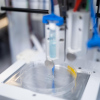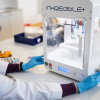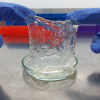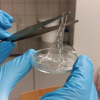Bioink and bioprinting for wound healing
Technology description
| The name of the technology: | Bioink and bioprinting for wound healing |
|---|---|
| Challenge: | Wound healing is a complex and challenging process that can be complicated by various factors such as infection, poor blood supply and tissue loss. Traditional methods of wound healing often involve the use of skin grafting, which can be limited by the availability of donor tissue and can lead to significant scarring. The use of 3D bioprinting and the application of bioinks with special properties such as high biocompatibility, optimized mechanical properties, and the ability to promote cell growth and proliferation may help in the treatment of wounds and skin injuries. |
| Description: |
Our bioinks are specifically designed for 3D printing of skin tissue with applications in healing skin wounds of various types. Bioinks combine natural polymers with nanoparticles of different nature possessing bioactive properties. Bioinks can be printed with high precision using 3D bioprinting, allowing the creation of complex tissue structures with tunable mechanical properties that match the requirements of the wound size and position. Bioinks not only promote cell adhesion and proliferation, but in particular have the ability to release bioactive substances in a controlled and sustained manner to promote the healing process. The bioinks developed by us and presented in the demonstrations have proven effects in the regeneration of skin tissue in particular. The carefully designed blend of chitosan and polyethylene glycol (PEG) thus promises a remarkable advance in the field of regenerative medicine. The ink is based on chitosan, a polymer of natural origin known for its biocompatibility, antimicrobial properties and wound healing ability. Chitosan serves as the backbone of the gel and provides a supportive matrix for cell growth. The innovative formulation of this bioincubate offers a number of benefits. In particular, its stretchability mimics the elasticity of human skin, allowing for seamless integration between the bioinkoust and the host tissue. This elasticity promotes better wound healing, reduces scar formation and ensures long-term stability. In addition, the chitosan component of bioinkoust exhibits antimicrobial properties, thereby reducing the risk of infection and providing a sterile environment conducive to tissue regeneration. The gel formulation is carefully designed to promote cell adhesion, proliferation and migration, facilitating the regeneration of healthy and functional skin tissue. The designed Bioinkoust has been thoroughly tested in laboratory tests at the cellular and tissue level. It is currently being validated in an animal study. |
| Commercial opportunity: |
Our Bioinkoust technology has the potential to significantly advance the treatment of wounds and skin injuries by providing a highly effective and customizable solution. It may find application in a wide range of medical professionals, including wound care specialists, plastic surgeons and dermatologists, as well as in research facilities to study skin biology and wound healing mechanisms. We are currently seeking commercial opportunities for the bioinks we have developed by partnering in the specific development and application of our deliverables. At the same time, we also offer all our experience and know-how in the possibility of development and production of customized bioincubates and gels for various applications - with or without the application of bioprinting, with the use of nanoparticles and bioactive particles of different nature, with the possibility of in vitro and in vivo testing. |
| IP protection status: | know-how |
| Development status: |
Phase 2Corresponds with TRL 3 and TRL 4 Feasibility study. There is a realistic design of the technology and the initial tests in the laboratory are leading to the specification of the technology requirements and its capabilities.
|
| Partnering strategy: | Co-development Collaboration licensing |
| More information: | |
| Images: | |
| Categories: | Life Science and Health Chemical and bioengineering |
| Owner of a technology: | Ing. Vratislav Čmiel, Ph.D. |




